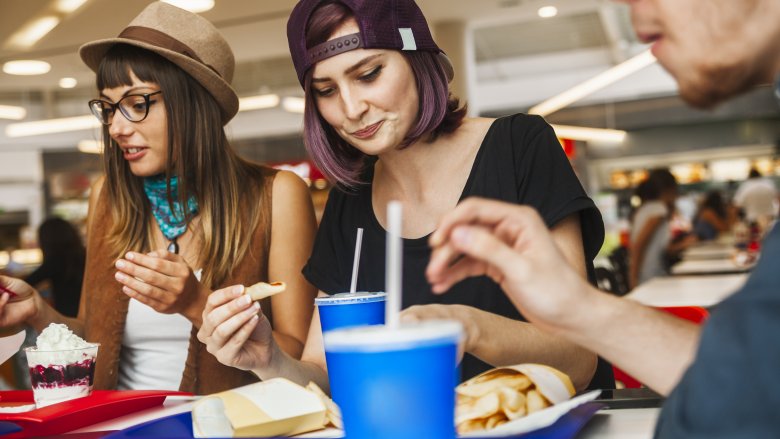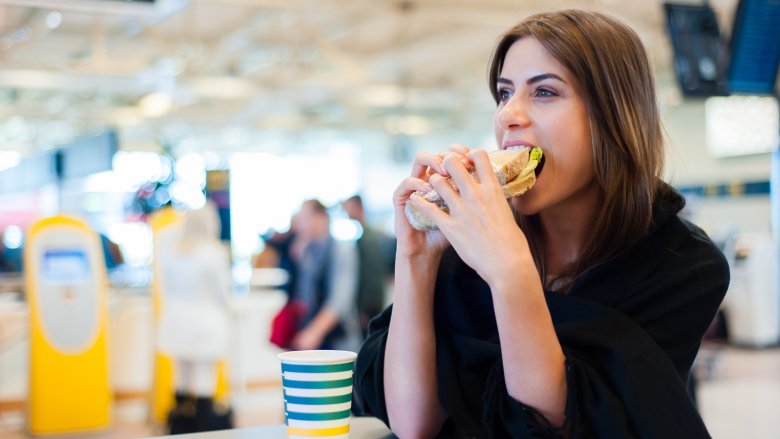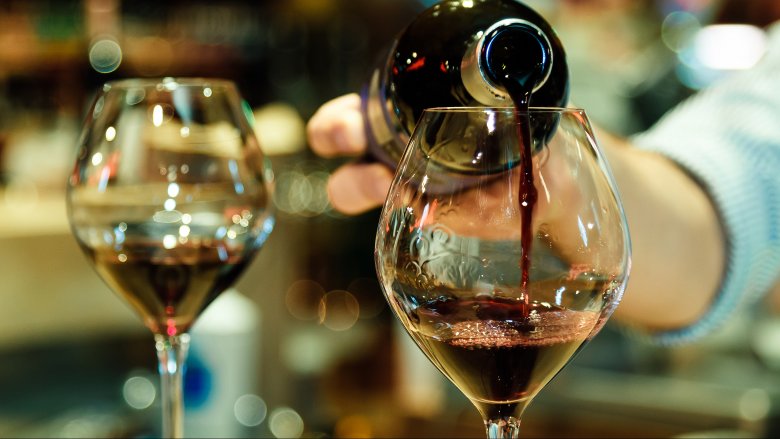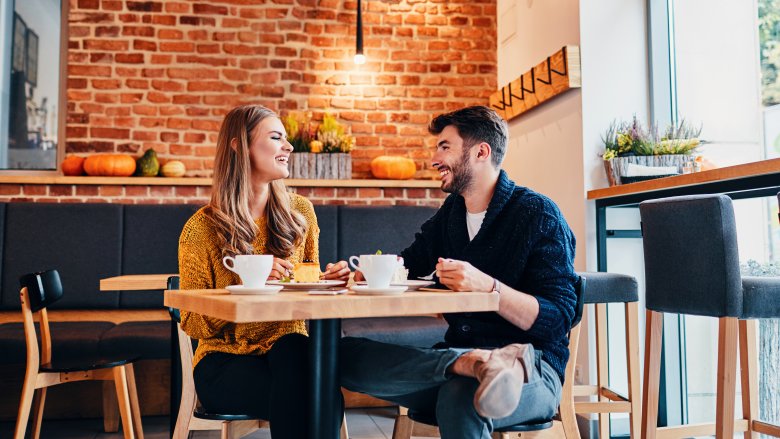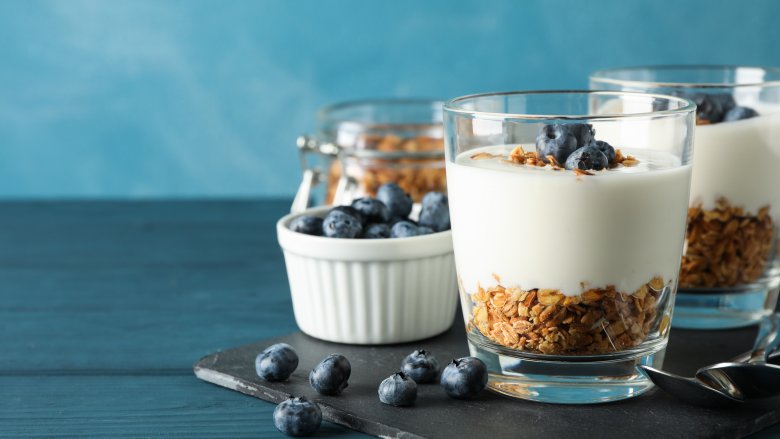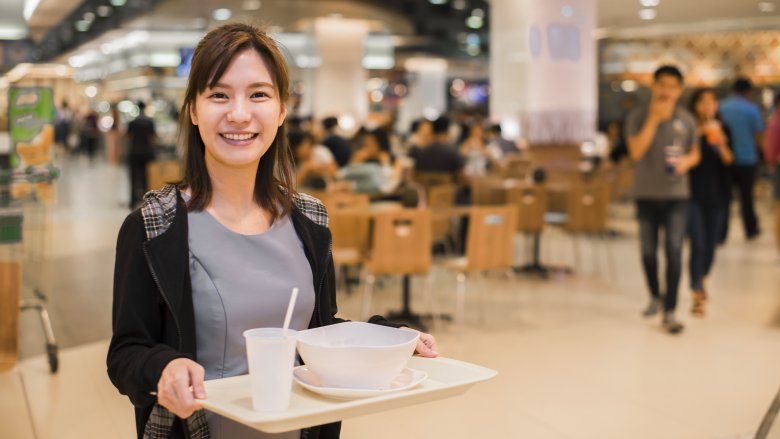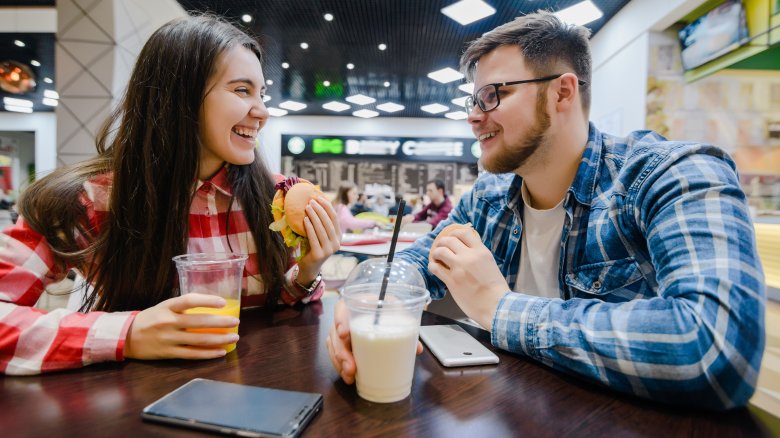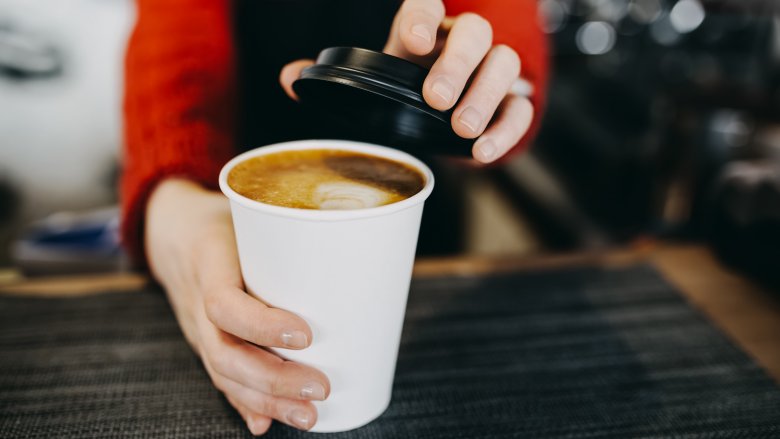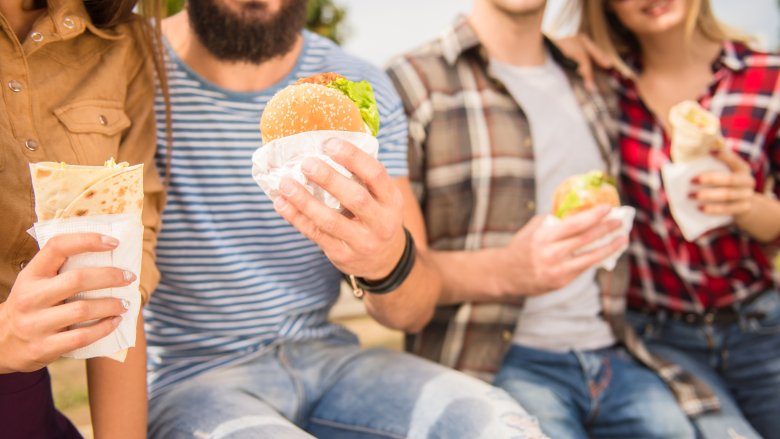Sneaky Ways Food Courts Are Scamming You
These days you'll find food courts in many different places. They're anywhere from malls and wholesale clubs, to airports where on long travel days it's nice to pass the time until your next flight with a glass of wine. During a shopping spree, food courts are a place to put up your feet and re-energize. Grocery stores are growing from buying food to make at home to buying food to eat in-store. They're serving alcohol and providing a more social environment to meet the demands of today's customer. As much as food courts seem to be providing what their customers are asking for, don't think they don't have a hidden agenda of their own.
Serving food to make customers happy may be one reason retailers are fighting to keep food courts around, but food courts are using low menu pricing, fast service, and unique dining trends for their own well being. Here's the inside scoop into how food courts are scamming their customers.
Food courts raise prices when there are no other options
Airports normally recommend arriving two hours before a domestic flight, but what happens when you make your way through security with too much time to spare? Even worse, what if you arrive two hours prior to take off and your flight is delayed? What do you do then? Large airports, like LAX, have you covered with dozens of food options available between gates. Grabbing a bite may help pass time, but it comes at a pretty steep price.
That same brand of water you threw out before security is now double the price inside the airport walls. A simple egg bagel served at the San Francisco airport sells for a whopping $8.50, but that's not even the most shocking. According to Zomato (via New Food Economy), an order of fish and chips along with a chocolate brownie at Tigrin's Irish Pub at JFK would cost you over $25... plus tax. How could that be? George John, a marketing professor at the Carlson School of Management gives insight into the price spike. "They have a captive audience," he says, "with fewer choices."
Limited options and no way out may be a huge reason airports jack up prices, but high operations costs are another. With limited inventory space, items are delivered in smaller quantities and during off-peak hours, and security clearances mean the process takes longer. Rent at airport locations also tends to be higher. These small details add up and travelers have to eat the cost, literally.
Food courts are serving alcohol to slow people down
Wine and beer are no longer something you'll only find in the aisles of your local liquor store. Grocery stores are adding to their buffets and sit-down cafes by now serving up alcohol as a part of an elevated shopping experience.
That elevated shopping experience means a grocery store is no longer just a grocery store. Take Whole Foods Honolulu for example, that offers 24 beers on tap at their modern Kahala Puka's bar. If you're not a beer fan, you may be more intrigued by Mariano's Fresh Market in Chicago and their Sunday mimosa parties. Food Service Analyst Phil Lempert says these additions are a way to prolong a customer's exit. "People like being able to walk around the store more relaxed and have a glass of wine or a beer while they're shopping... they're seeing more new products that maybe [they'd miss] if they're just running in and out in 20 minutes."
Alcohol may help customers relax and discover new items, but it also could result in what Hustle likes to call "drunk shopping." In a 2019 survey of over 2,000 alcohol consumers, it was discovered that 79 percent were guilty of making at least one drunk purchase. While strolling the aisles of a grocery store, that could be a dangerous combination.
Low food prices at food courts are planting the seed for larger purchases
It's hard to argue over food prices at places like IKEA where you can eat a full meal for $3.99, or stack up on their hot dogs for 50 cents each. Although IKEA serves low priced, quality food customers can trust, they are still very much in the furniture business. The food court is just their way of reeling people in to eventually spend the big bucks.
Chris Spear used to work as a chef for IKEA and says the company's policy is "to be the absolute lowest price on that item within a 30-mile radius, even if it means selling at a loss. They're reinforcing the low-price profile of the store."
Spear goes on to explain how IKEA is okay with operating at a loss when it comes to their food court items because there are bigger dollars to be spent. "They take a hit on the food but just sold you $1,000 in furniture. It's the same thing other stores do with loss leaders to get you in the door..." The next time you bite into that 50 cent hot dog, know that IKEA plans on seeing a lot more than quarters in the future.
'Healthy' food court menu items may not be as healthy as they seem
Salads and smoothies may seem like the healthier choice on the food court menu — making it more likely that you'll feel comfortable making a purchase — but beware of the add-ins that really add up. Parfaits and smoothies, for example, are masked as healthy, containing fruit and yogurt, but dietitian Kara Landau begs to differ. "I avoid the large yogurt parfaits or fruit smoothies... they all can actually be extremely high in either sugar or additives and preservatives that may aggravate the gut."
Sandwiches seem like a good source of carbs, protein, and dairy all layered into one, but that is not the case according to dietitian Manuel Villacorta. If cold sandwiches are an option on your next trip to the food court keep walking. "They are calorie dense, nutrient scarce and overly sized," he says. "The fillings of the sandwich... are full of highly processed meats with old lettuce."
Speaking of lettuce, the amount of sodiumin a simple food court salad will shock you. The American Heart Association recommends a daily limit of no more than 2,300 milligrams of sodium a day. A chicken Caesar salad from the Costco food court would blow your entire daily allowance and then some containing 2,680 milligrams in a single meal.
There's a reason non-members can often enjoy food courts
Members of wholesale clubs like Sam's Club spend anywhere from $45 to $100 a year on memberships to gain exclusive access to early shopping, discounts, cash rewards, and even the food court. The food court however, is not a member-only perk. Anyone can enjoy their blue raspberry icees, soft pretzels, and Nathan's hot dogs. The same goes for Costco. Anyone can enjoy their famous $1.50 hot dogs, but you won't leave without possibly paying the price.
In order to scarf down anything on the wholesale giant's menu, you must usually enter through the exit. That means twice in your visit you'll have to pass the membership desk. Have you ever heard of the marketing rule of seven? It's an age old principle that says "a prospect needs to 'hear' the advertiser's message at least seven times before they'll take action to buy that product or service." In theory, if the marketing rule of seven truly works, it will take four trips to the food court before a non-member finally breaks down and purchases an annual membership.
Of course, it might not take that long at all. Just think of how many happy customers you'll see walk by while you munch away on your tasty, cheap food. There's a good chance you'll stop by that membership desk after your first visit, and food courts know it.
Some food courts serve the food they sell so you'll buy it after you try it
Do you remember the time when food samples were free? While some still are, grocery stores are taking it to the next level with the creation of the grocerant. A grocerant combines the words grocery and restaurant, because more and more grocery stores are building eat-in dining areas for customers to enjoy prepared foods. These areas are also ways for the grocery store to spotlight what's on their shelves, and the trend has gone international. Takashi Igarashi, head of Seijo Ishii's groceant in Japan says that with customers taking advantage of the eat in option, they "expect customers to eat at the grocerant, discover the excellent quality of the ingredients on our shelves and then buy them." It's like Pinterest in real life.
A frequent customer of Japan's Seijo Ishii says, "I feel like these meals are also food samples for a fee." Though that may be true, perhaps grocerants are trying to help customers make a decision. A 2017 survey by the Food Marketing Institute reveals that 65 percent of Americans are undecided about what's for dinner two hours before they plan to eat. Grocerants are giving customers the opportunity to make decisions and "to see how to prepare the food sold in the supermarket and taste the quality first hand."
Food courts are going local to keep you in stores and offline
A large portion of retail sales are now made by the click of a button. Retail stores are closing in droves and if the retail apocalypse of steady store closures continues an estimated 75,000 stores will say goodbye to their storefront by 2026. Big retail giants are no longer driving foot traffic and the number of apparel stores has dropped by half since 2015, but malls may still have one thing keeping them alive — food. According to a report by Jones Lang LaSalle, 40 percent of shoppers will choose the mall they go to based on the food offerings. "There's a direct parallel between the quality of food and time spent in a mall," says Jones Lang LaSalle, head of retail advisory Naveen Jaggi.
Food chains like McDonald's and Wendy's won't cut it either. When it comes to quality of food, today's shoppers want local, healthy choices they can't get anywhere else. Malls are embracing these changes by upping their food offerings. A $500 million renovation to the Beverly Hills Center in Los Angeles may include things like a ramen bar and poke bowls.
There's a reason malls are going to such great links to bring in the food you want. These unique food experiences result in more shoppers coming to their malls — and getting you in the door is half the battle.
There's a reason you can see merchandise from the food court
Don't think that while you're taking a break from your shopping to grab a bite to eat at the food court that stores are done selling. While you're sitting down to take a load off, they're persuading you to buy more. Take malls for example. Retail stores are visible while you're dining in. A survey from Jones Lang LaSalle says the biggest foot traffic spikes are found to be of the retailers closest to the food court — it makes sense that while you eat, your eyes would wander over to do some window shopping. In fact, retail sales are 12 percent higher in customers who eat at the food court versus those who don't.
Malls aren't the only ones that know food is where the sales are at. Cheat Sheet warns customers to be wary of any place that allows you to take a seat. That's because stores view those places, including food courts, as a place to unload their stock. They even go as far as strategically placing the seating towards the merchandising so you can't escape it.
If you think you're done shopping but you want to grab a bite, it may be best to keep your eyes focused on your plate.
Food court coffee is being used to lure you in
In 2018, a survey by the National Coffee Association revealed that 64 percent of Americans drink at least one cup of coffee a day. With coffee shops being a $45 billion industry, it's no wonder everywhere from malls and airports to retail stores are looking to serving up a few cups of their own. "When you are a new retailer coming in and you want to attract customers outside of just your branding, a good strategy is to put in a coffee [shop], says Robert Carter, executive director of food and fashion trends at NPD Group.
Coffee shops create a conversational vibe. Retailers will place them at the entrance of the store to welcome people in. Target is a perfect example. They currently have 1,300 Starbucks in their stores across the U.S. Most people never leave Target with only the items they came for, but if your Target has a Starbucks, you're probably buying more than you planned before you even get to the store's merchandise. And now that you have that coffee and pastry situated in your cart, you're probably going to spend a little more time lingering in the aisles while you enjoy your treat. Congratulations, they got you, hook line and sinker.
Food court menus go heavy on the visual marketing
The next time you're waiting in line at a food court, take a look at the menu. Most menus will emphasize their offerings with large photos, much like you might see at Target or Costco. You have to squint to read the words, but the pictures of hot dogs and pizzas are clearly visible — even when you're still shopping nearby. Those photos increase restaurant sales by 30 percent according to menu engineer Greg Rapp. Yes, you read that correctly. A menu engineer is a legit position.
Brian Mennecke, an associate professor of information systems lends a little insight into why sales increase thanks to photos on the menu. "You respond to the image on the display like you would respond to a plate in front of you." Instead of searching the menu yourself, or the typical I'll have what she's having, Mennecke says, "if you're hungry you respond by saying, 'I'll have what's in that picture.'" And just like that, you purchased exactly what the food court wanted you to purchase.
Delicious food courts scents are no accident
It's nearly impossible to pass by a food court and not be drawn in by the aroma of what's cooking, no matter what it is. Whether it's a newly out of the oven pizza, freshly baked pretzel, or recently drizzled frosting on a cinnamon roll, it can be hard to walk on by without indulging in some of that good stuff you're smelling — and that's just what food courts are hoping for. They call it scent marketing. If you're not familiar, scent marketing is the "practice of using a pleasant aroma to enhance a company's brand image, improve customer experience and increase sales" according to FrangranceX. In fact, some stores are purposely designed with this in mind.
Cinnabon bakes new rolls every 30 minutes to keep the enchanting smell in the air. They even built their stores with the ovens in the front so the fresh aroma has a shorter distance to travel to people's noses and turn on their taste buds. In fact, the very reason they place their locations in food courts at malls and airports is because those locations allow their scent to drift to nearby locations, drawing in customers who, before their noses told them otherwise, had no idea they were craving a cinnamon roll. That wouldn't happen at a free-standing location. It looks like it's not only calories in cinnamon rolls we should watch out for.
